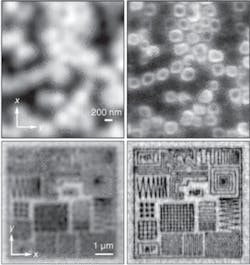New resolution law for far-field fluorescence microscopy discards the diffraction limit
Most optical textbooks still portray far-field optical microscopy as being limited by diffraction. Scanning near-field optical microscopes image well below the diffraction limit, but are restricted to scanning of surfaces (proximal imaging). But evidence shows that the diffraction resolution limit of a far-field fluorescence microscope can be overcome by stimulated-emission depletion (STED).
Developed by Stefan Hell of the Max-Planck-Institute for Biopyhsical Chemistry (Göttingen, Germany), STED microscopy superimposes the fluorescent spot of a scanning microscope with a doughnut-shaped quenching beam that is intense enough to deplete excited fluorophores (Fig. 1). Hell and his colleagues have now squeezed the fluorescent spot down to 16 nm—that is, to about 1/50 of the light’s wavelength.1 More intriguing, the resolution of STED microscopy has been shown to follow a new resolution law in which the resolution is improved beyond the traditional diffraction limit by a factor of ( 1 + ζ )0.5, in which ζ is the so-called saturation factor, or the ratio of the actual intensity to the saturation intensity.
This new resolution law takes into account that, in STED microscopy, the fluorescence quenching is oversaturated. The saturation intensity is defined as the intensity at which 50% of the fluorescence is depleted, and is on the order of megawatts per square centimeter. Therefore, at intensities much greater than the saturation intensity (ζ much greater than 1), the fluorescence is quenched everywhere in the focal spot except very close to the center. As a result, the diffraction-limited fluorescence spot can be squeezed to the size of a fluorescent molecule by increasing ζ.
The researchers have verified this new resolution law and have demonstrated the sharpest images ever produced with regular lenses and visible light (see figure).3 Moreover, the narrowed fluorescent spot has important implications for observing molecular interactions through fluorescence-fluctuation spectroscopy.4
Effecting a reversible transition
The STED technique is only one aspect of this story, however. Back in 1995, Hell pointed out that a similar increase in resolution could be attained by inhibiting the fluorescence with a diffraction-limited, but “holey,” focal intensity that pumps the dye into the dark-triplet state. Thus, STED and the triplet pumping idea can be regarded as special cases of a general scheme to achieve resolution beyond the diffraction limit in microscopy, exploiting reversible saturable-fluorescence transitions (RESOLFTs) between the fluorescent and nonfluorescent states of a marker. Provided such a reversible transition is effected with a beam featuring a local zero, the resolution of a scanning microscope can be arbitrarily sharpened by adjusting ζ to be much greater than 1, whether the beam is limited by diffraction or not.
In a RESOLFT microscope, increasing the maximum intensity is not the only way to produce large values of ζ, because one can also reduce the saturation intensity. Moderate or even very weak saturation intensities are encountered with optically bistable compounds such as photoswitchable fluorescent proteins and photochromic materials. These alternative RESOLFT variants are expected to provide huge saturation factors at very low values of maximum intensity, and show considerable potential for creating optical microscopes with nanoscale resolution using ordinary lenses and intensities provided by conventional lamps.
REFERENCES
1. V. Westphal, S.W. Hell, Phys. Rev. Lett. 94, 143903 (2005).
2. S. W. Hell, Phys. Lett. A 326, 140 (2004); www.4pi.de.
3. V. Westphal et al., J. Phys. B 38 (2005).
4. L. Kastrup et al., Phys. Rev. Lett. 94, 178104 (2005).
About the Author
Uwe Brinkmann
Contributing Editor, Germany
Uwe Brinkmann was Contributing Editor, Germany, for Laser Focus World.
